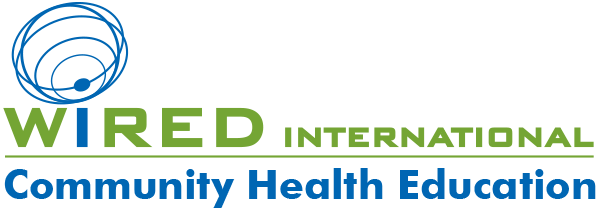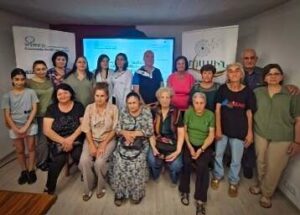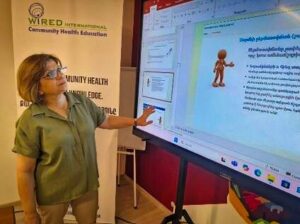By Allison Kozicharow; Edited by Elizabeth Fine
Introduction
In the course of a long-standing collaboration, this August and September NGO Miasin joined with WiRED International–Armenia to produce a series of lectures titled, “The Role of a Community Health Worker in the Community: Theoretical and Practical Experience.”
These lectures grew out of knowledge gained through a successful six-month online pilot program to train community health workers (CHWs) to address relevant topics in public health — strengthening participants’ ability to provide primary medical assistance and raise public health awareness.
The two-part lecture program focused on the following training topic: “First Aid: Approaches to Patient Assessment in Cases of Injury.” Lecturers used modules from WiRED International’s Basic CHW curriculum.
Lecture Series Part 1
Lectures took place in Zvartnots and in Ararat in partnership with the “Ararat Youth Initiatives Center” NGO. The topics included an assessment of vital signs and basic measurements as well as types of burns and first aid. The practical training segment of the lecture focused on methods for measuring blood pressure and determining blood oxygen saturation.
About 50 people, aged 18 to 70, participated in the lecture. They were a mixed group from the community, including:
- Active community members,
- Residents displaced from Artsakh,
- Public and municipal employees and
- Teachers and students.
Participants were asked to evaluate the training, and the most common responses described how the lectures enable participants to:
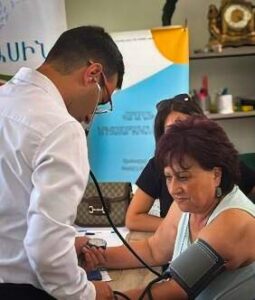 Gain new knowledge on healthy lifestyles, disease prevention and first aid;
Gain new knowledge on healthy lifestyles, disease prevention and first aid;- Acquire practical skills that would be useful within their families and their community;
- Better understand the role and responsibility of CHWs;
- Develop communication and information-sharing abilities;
- Become prepared to actively engage in community health preservation efforts;
- Be more aware of personal health issues, to monitor their own health more carefully and to consult a doctor at first signs of concern;
- Continue participation in similar health education events and
- Suggest subjects for future lectures and training, such as stress and depression, diabetes and air pollution.
The results demonstrated the eagerness and engagement of the participants to promote public health awareness and to learn more about health and environmental topics.
Lecture Series Part 2
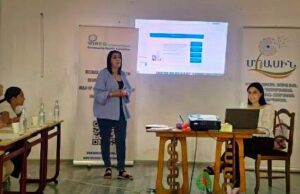 WiRED, Miasin NGO, CHW program participants and family nurses from the Parpi Medical Ambulatory collaborated on providing audience-targeted lectures. The first targeted group comprised 15- to 16-year-old students. The second group included university students, community and state employees, teachers and active community members — about 50 people overall.
WiRED, Miasin NGO, CHW program participants and family nurses from the Parpi Medical Ambulatory collaborated on providing audience-targeted lectures. The first targeted group comprised 15- to 16-year-old students. The second group included university students, community and state employees, teachers and active community members — about 50 people overall.
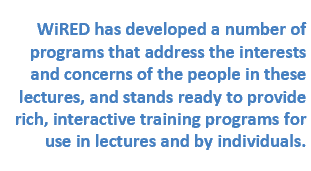 The training goal was to develop participants’ — especially youth’s — skills in properly assessing emergency situations, acting quickly and responsibly and ensuring both their own and the victim’s safety before professional medical help arrives.
The training goal was to develop participants’ — especially youth’s — skills in properly assessing emergency situations, acting quickly and responsibly and ensuring both their own and the victim’s safety before professional medical help arrives.
Sessions included both practical and theoretical components — first aid for injuries, burns and bleeding and for electric shock. The sessions comprised lectures and practicums as well as Q&A and interactive games. Participants completed pre- and post-tests to evaluate what the students learned in the sessions.
Attendees reported that the training helped them to:
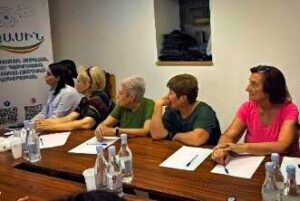 Properly assess emergency situations and victims’ conditions;
Properly assess emergency situations and victims’ conditions;- Learn how to provide first aid for bleeding, injuries and burns;
- Understand safety and responsible behavior;
- Remain active and engaged through Q&A and interactive exercises and
- Propose future health topics, such as stress and depression, diabetes, cancer and animal bites.
The lecture team (see sidebar) concluded that the sessions made a positive impact on participants’ medical knowledge and practical skills, increased their confidence, improved their emergency assessment and encouraged positive behavior. Their proposed health topics reflected a growing interest in public health and a desire for continued education.
Conclusion
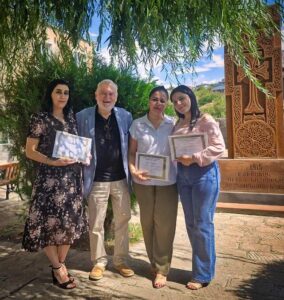 The response to the entire lecture series highlights the importance of continuing and expanding initiatives to promote health awareness, strengthen community health preparedness and train everyday people to be CHWs. WiRED has developed a number of programs that address the interests and concerns of the people in these lectures, and stands ready to provide rich, interactive training programs for use in lectures and by individuals.
The response to the entire lecture series highlights the importance of continuing and expanding initiatives to promote health awareness, strengthen community health preparedness and train everyday people to be CHWs. WiRED has developed a number of programs that address the interests and concerns of the people in these lectures, and stands ready to provide rich, interactive training programs for use in lectures and by individuals.
Lecture Series Working Team
- Sebouh Baghdoyan — WiRED International Representative in Armenia
www.wiredhealthresources.net | Facebook: WiRED Armenia - Gevorg Chichyan — President, MIASIN NGO
Program Director, “The Role of the Community Health Worker in the Community”
www.miasin.am - Lusine Petrosyan — Co-founder, MIASIN NGO; Program Coordinator
- Sossi Avagyan — Co-founder, MIASIN NGO; Program Coordinator
- Dr. Arman Aghikyan — Public Health Specialist
- Rima Ispiryan — Family Nurse, Parpi Medical Ambulatory; CHW Program Participant
- Merry Melikyan — Family Nurse, Parpi Medical Ambulatory; CHW Program Participant
Learn about the WiRED–Armenia alliance in past years here:
- Update from WiRED International–Armenia, June 28, 2023
- Pilot Lecture Series on Health Conducted in Armenia, October 7, 2023
- Refugees from Nagorno-Karabakh and Ukraine Fleeing to Armenia, February 3, 2024
- Second Lecture Session in Series on Health Takes Place in Armenia, March 11, 2024
- Lecture Series on Health Continues in Armenia, May 27, 2024
- WiRED International Celebrates 12 Years of Fruitful Partnerships in Armenia, August 21, 2024
- Lecture Series Promoting Health Awareness in Armenia Concludes, November 23, 2024
- Community Health Worker Online Education Begins in Armenia, February 24, 2025
